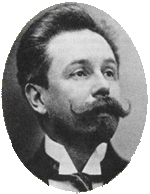Piano Sonata No. 4 (Scriabin)
The Russian composer and pianist Alexander Scriabin (1872–1915) wrote his two-movement 4th Piano Sonata in F sharp major op. 30 in 1903 and also wrote a programmatic poem for it.
Emergence
Scriabin's 4th piano sonata was written in 1903, although according to letters from the composer it was conceived a little earlier. Larger parts of Scriabin's Third Symphony were written at the same time .
characterization
The sonata is in two movements and, with a playing time of about 7 to 8 minutes, is the shortest of Scriabin's sonatas:
- I. Andante
- II. Prestissimo volando
Scriabin wrote a poem (originally in French) for this sonata after it was published, the beginning and end of which are as follows:
- In a light veil, transparent mist
- A star shines softly, far away and lonely.
- [...]
- Flaming sun! Sun of triumph!
- I come closer to you in my longing
- Bath me in your wave movement - you joy God!
- I suck you in, sea of light, you light of myself,
- I devour you!
The main theme of the first - monothematic - movement is characterized in its first part by a double fourth upward jump , in its course a chord appears several times which structurally corresponds to Wagner's Tristan chord . Fourth motifs determine not only the further course of the andante (following the poem Scriabin), which is more contemplative and expresses longing feelings , but also the second, attacca subsequent fast movement. This follows the sonata form and reflects - again in accordance with the composer's poem - a quasi cosmic flight to a star, the source of longing. The tempo designation “volando” also means “flying” (the “principle of flight” forms a metaphor that shapes Scriabin's philosophical speculations and thus many of his compositions). In the coda the main theme of the first movement is taken up again in a triumphant triple forte .
The 4th piano sonata was to be Scriabin's last multi-movement sonata composition; the numbers 5 to 10 are all in one movement.
The older composer colleague Alexander Glasunow was enthusiastic about the sonata and characterized it as follows after its publication: [...] It is original, full of adorable beauties and the thoughts in it are expressed with unusual clarity and brevity.
Individual evidence
- ↑ cit. n. Sigfried Schibli: Alexander Scriabin and his music . Piper, Munich / Zurich 1983. ISBN 3-492-02759-8 , p. 174
- ↑ cit. n. Igor Fjodorowitsch Belsa: Alexander Nikolajewitsch Skrjabin . Verlag Neue Musik, Berlin 1986. ISBN 3-7333-0006-8 , p. 117
literature
- Igor Fjodorowitsch Belsa: Alexander Nikolajewitsch Scriabin . Verlag Neue Musik, Berlin 1986. ISBN 3-7333-0006-8 , pp. 116–120.
- Sigfried Schibli: Alexander Scriabin and his music . Piper, Munich / Zurich 1983. ISBN 3-492-02759-8 , pp. 172-175
Web links
- Alexander Scriabin's poem for the 4th piano sonata
- Scriabin: 4th Piano Sonata : Sheet Music and Audio Files in the International Music Score Library Project
